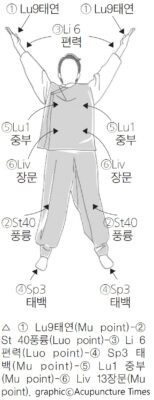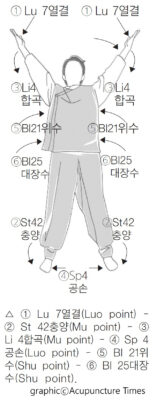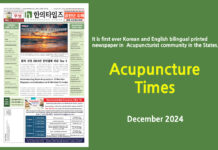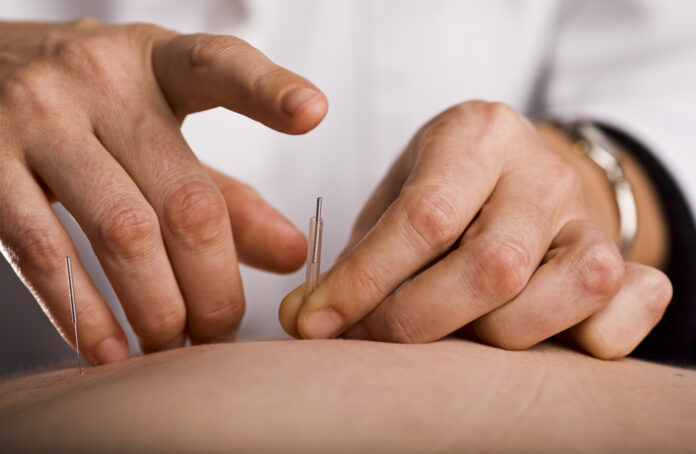Understanding Point Selection theories of Yuan-Luo Yin-Yang Points Selection
Taiji principle contains three elements theory and 12 meridians.
By Brandon SJ Oh, L.Ac.
It requires accuracy of diagnosis for selection of acupuncture points selection and it also makes possible for using less needles for each treatment in order to magnifying treatment effect.
Such cases like chronic symptoms, pathogen moved one meridian to the other or co-existence of fullness and emptiness which usually makes harder to determine fullness and emptiness of upper and lower body, and a patient with great fatigue require to control interior and exterior relationship or same named meridian which are paired with hands and feet. Same named meridian means spleen and lung meridian which are sharing Taiyin as hand Tai Yin Lungs and foot Tai Yin Spleen, and triple burner and gall bladder sharing Shaoyang, and heart and kidney sharing Shaoyin, etc.
In such cases introduced above, it makes easier as stimuli of upper or hand and lower or foot meridians that use same name meridians to balance its upper and lower body’s fullness and emptiness. For example, if you select acupuncture points based on Yuan-Luo Points Relationship you should select one from upper body and choosing another point on lower body which are located either lung meridian or spleen meridian.
▲ 원락음양취혈법 태음경 Point Selection theories of Yuan-Luo Yin-Yang Points, Taiyin Meridian

You maybe have a question after reading acupuncture points listed above.
Two Mu points from lung and spleen meridian were listed and it does not seem clear which meridian will be beneficial with series of acupuncture points listed. Let me explain. Physiology of spleen is for transporting energy that was processed from digestion to the lungs. And the lungs accept energy from spleen and distribute through body. This is physiology of spleen and lungs.
As we think over the meaning of acupuncture points selection theory that I explained earlier, it already contains diagnosis and treatment plan.
But once normal relationship or physiology of lungs and spleen relation was broken, it leads indigestion or bloating with loss of appetite and/or makes diarrhea and eventually water dampness is building up. Water dampness causes heaviness, short of breath, increases phlegm and coughing. It could be understood by imagine soil that holds too much water in it. Little wetted soil is physiology of Taiyin meridian.
In case the meridian starts to have more than normal amount of water or dampness, it leads symptoms such as body heaviness, short of breath or coughing, and creation of phlegm.
For resolving various symptoms of Taiyin meridian, I would like to recommend for using Shu points of spleen and lungs or Mu points of lungs and spleen.
If one wants to help and enhances digestion and add Cv12 with 2 Mu points or 2 Shu points of lungs and spleen, it would reduce treatment effects of acupuncture treatment.
If one really needs to add Cv12, use Mu point of spleen, Liv 13 instead of mixing Mu or Shu points. Usually, insert Cv 12 first then insert Liv 13. Removing needle will be first Cv12 then Liv 13.
▲ Yuan-Luo Yin-Yang Points Selection, Yang Ming Meridians 원락음양취혈법 양명경
 Pathology of Yang Ming meridian causes: acute indigestion, intussusceptions, bell’s palsy, chronic anorexia, chronic indigestion, heat sensation on belly button, stomatitis, and hemorrhoid. And Qi stagnated on stomach and it bothers moisture distribution from large intestine and it eventually leads dryness on skin specially on hands and feet. Skin dryness is due to lost of control of Qi, blood, and body fluids.
Pathology of Yang Ming meridian causes: acute indigestion, intussusceptions, bell’s palsy, chronic anorexia, chronic indigestion, heat sensation on belly button, stomatitis, and hemorrhoid. And Qi stagnated on stomach and it bothers moisture distribution from large intestine and it eventually leads dryness on skin specially on hands and feet. Skin dryness is due to lost of control of Qi, blood, and body fluids.
Principle for treatment symptoms due to loss of control of Qi, blood, and body fluids is required to control of Yang Ming energy by lungs’ Luo points and Mu points.
Selection for either Mu or Shu points is based on nature of symptom, such as chronic or acute or position that patient feels most comfortable during treatment.
































